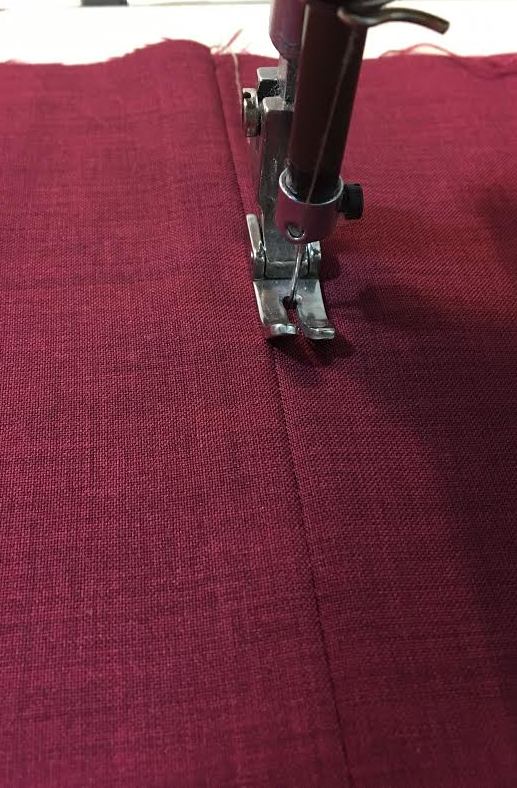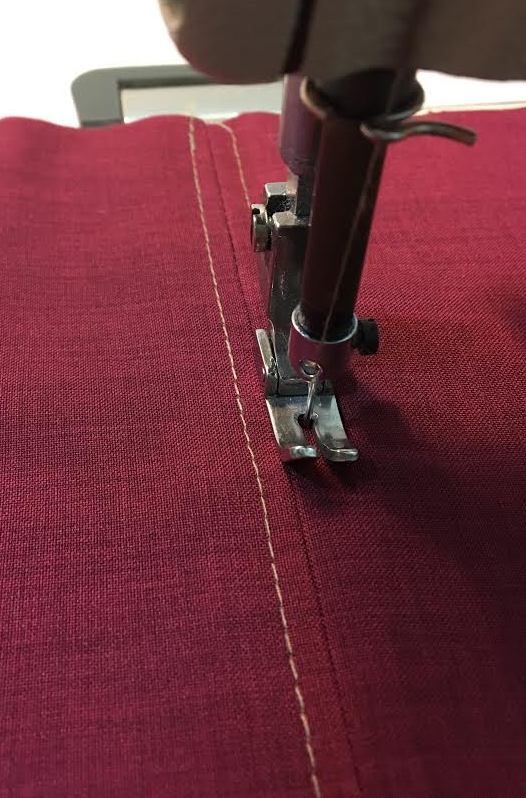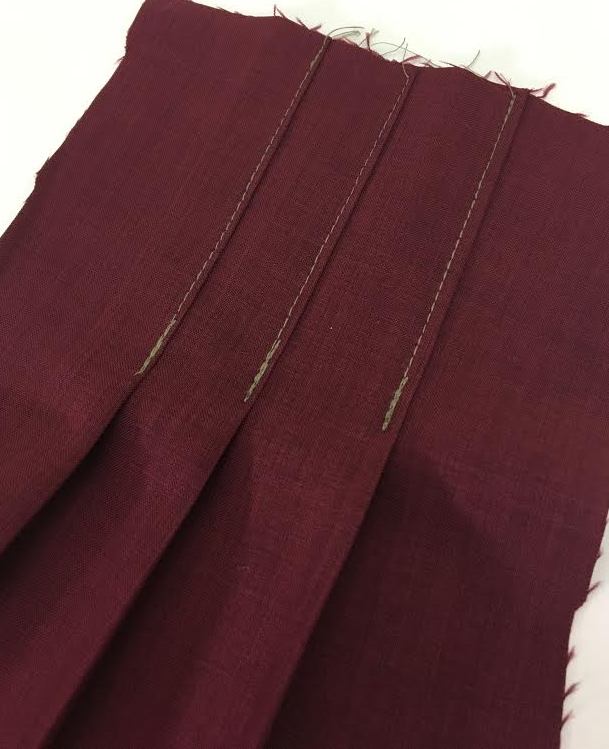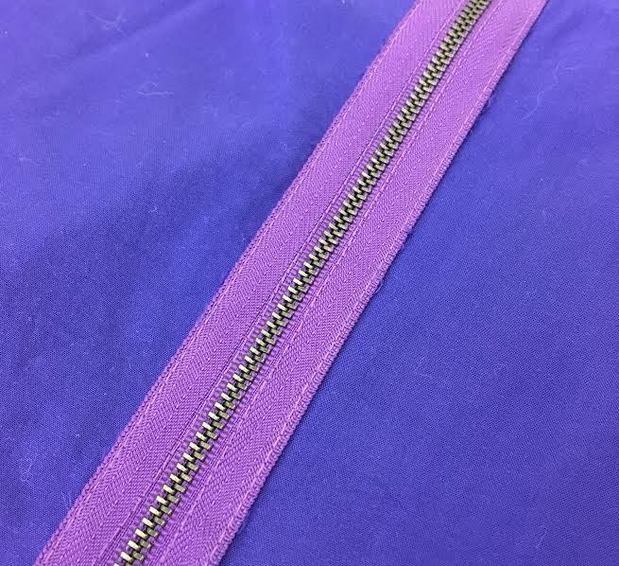|
Top-stitching is a single or set of machine stitches that are applied to the face side of the garment both for decorative and functional purposes. Top-stitching is extremely common on more casual items like sportswear, denim and active wear. If you are just getting started on sewing, top-stitching is a great way to add some uniqueness to the outside of the garment as well as practice straight stitching. Top-stitching is usually done with a longer stitch length so that it doesn't bulk up the fabric and create a smooth finish on the outside. When applied for decorative purposes, contrast thread creates the best effects. You can also experiment by top-stitching with zigzag and the embroidery stitches you have available on your sewing machine. The functional aspect of top-stitching really comes in handy if you are trying to keep certain pleats or excess seam allowance from flopping around on the inside of the garment. Top-stitching is a great tool to use along some seams not only for durability but also to keep seam allowance flat and pointing to a certain direction. Doing so maintains the garment's structure and requires less ironing of the seams after washing. So now that you know a bit about the magic of top-stitching, lets do some practice exercises! We encourage you to practice both decorative and functional top-stitching on scrap fabric before applying it to your final project. Top-stitching requires a certain comfort level and stability in order to achieve smooth, even stitching. Don't get discouraged if your first stitches are uneven. Keep practicing and you'll be a pro in no time! Decorative and Functional Top-stitching Along The Seam Top-stitching along seams is actually quite simple because you can use the seam line as a guide. It's really up to you and your design specifications how far from the seam you want to top-stitch: 1/4"-1/2" away from the seam is used most commonly. You can also top-stitch on just one side or on both sides of the seam line. In addition, it is your choice whether you'd like to add a single stitch or cluster of stitches. Top-stitching on Both Sides of the Seam: 1. When top-stitching on both sides of the seam line, make sure you finish the raw edges of the seam allowance individually by serging or applying a zigzag stitch. 2. After clean finishing the raw edges, pin and machine stitch the seams together at the desired seam allowance. 3. Iron the seam allowance open so as shown bellow. 4. Working on the face side of the fabric, align your presser foot with the seam line and begin stitching making sure that you are stitching through the seam allowance on the back side of the fabric. Everything should remain smooth and flat. Repeat this step on the other side of the seam line in order to achieve a single row of even top-stitching on both sides. Topsticthing on one Side of the Seam Line 1. Pin and sew the seam together at the desired seam allowance. 2. Clean finish the raw edges together using a serging or zigzag stitch. 3. Iron all the excess seam allowance towards one side, depending on which side you want the top-stitching to be on. 4. Working on the face side of the garment again, apply a machine stitch at the desired distance from seam line. Make sure you top-stitch on the side that has the seam allowance at the back. The best practice for top-stitching is to align the seam line with the presser foot's edge and keeping it aligned as you top-stitch. If you want to add multiple rows of topsticthing, simply use the first topstitch as a guide to add additional stitching. The presser foot trick described above works wonders for creating evenly spaced rows of topsticthing. Other Uses For Topsticthing Here are a few examples of other common topstitching that is used for both decorative and functional purposes: Top-stitched Tucks: Keeps the excess of the tuck in place and adds a durable and decorative look. Top-stitching on top of box pleats, inverted pleats and side pleats: Keeps the pleat excess flat and maintains structure. Top-stitching around zippers: This type of top-stitching is mainly done for decorative purposes but it also keeps the edges of the seam allowance and zipper edges flat for more durability and comfort. Top-stitching on waistbands: This not only helps the waistband to lay flat and be durable, but it also adds a more casual look.
2 Comments
Viv Adams
11/15/2021 08:59:13 am
So much useful info in this article - and great pics - thank you. I haven't used a machine for over 40 years and now acquired one so very excited but I do want to learn the proper way of doing things so am grateful to you for the Topstitching article.
Reply
Marlene Dougliss
7/13/2024 09:36:45 am
Hi reading your arrival about topstitching it was very interesting.
Reply
Leave a Reply. |
The Blog:A journey into our design process, sewing tutorials, fashion tips, and all the inspiring people and things we love. Doina AlexeiDesigner by trade and dressmaker at heart. I spend most of my days obsessing over new fabrics and daydreaming new ideas. Sadie
Executive Assistant & Client Relations Manager Archives
November 2019
Categories
All
|
-
Sewing Tutorials
-
Basics
>
- Aligning Pattern Grainlines To Fabric
- Preparing Fabrics For Sewing
- Pinning Sewing Patterns To Fabric
- Placing Sewing Patterns On Fabric For Cutting
- Rotary Cutters or Fabric Scissors?
- Cutting The Sewing Patterns
- What Are Notches And How To Use Them In The Sewing Process
- Transferring Notches From Pattern To Fabric
- Transferring Seamlines to Fabric
- Staystitching
- Backstitching: A Complete Guide
- Hand Basting: A Complete Guide
- Sewing Continuous Bias Binding
- Darts >
-
Sewing Seams
>
- The Basics Of Seams And Seam Allowance
- How To Sew A Straight Seam
- Sewing Curved Seams
- Sewing Corner Seams
- Trimming And Grading Seam Excess
- Notching/Clipping Seam Allowance for Tension Release
- Sewing Topstitched Seams
- Sewing Corded Seams
- Sewing A Slot Seam
- Sewing A Gathered Seam
- Sewing Bias Seams
- Sewing Seams With Ease
- Sewing Seams With Crossing Seamlines
- Sewing Unlike Fabric Seams
- How To Iron Seams: Ironing Tools And Conventions
- Sewing With Knit Fabrics
- Understanding Stitch Length And Tension
- Sewing Unique Fabric Seams
-
Seam Finishes
>
- Seam Finishing Techniques - Overview
- Applying A Pinked Seam Finish
- Applying A Bias Bound Seam Finish
- Serging And Zigzag Seam Finishes
- Sewing A Self-Bound Seam Finish
- Sewing A French Seam Finish
- Sewing A Hong Kong Seam Finish
- Sewing A Mock French Seam Finish
- Sewing A Turned-and-Stitched Seam Finish
- Sewing Overcast Hand-Applied Seam Finishes
- Sewing A Flat Felled Seam
- Sewing A Hairline Seam Finish
-
Hem Finishes
>
- Garment Hem Finishes: Overview
- Sewing A Double Fold Hem Finish
- Sewing A Single Fold Hem Finish
- Sewing Bound Hem Finishes
- Sewing An Exposed Double Layer Bound Hem
- Sewing A Folded-Up Bound Hem with Pre-folded Binding
- Sewing A Hong Kong Hem Finish
- Sewing A Band Hem Finish
- Sewing A Bias Faced Hem Finish
- Sewing A Twill Tape Hem Finish
- Sewing A Rolled Hem Finish
- Sewing A Shaped Hem Facing
- Using Fusible Hem Tape And Webbing
- Finishing A Lace Fabric Hem
- Finishing A Leather Hem
- Sewing Faced Hem Corners
- How To Finish Lining At The Hem
- Finishing Fabric Corners by Mitering >
- Interfacing A Hemline: Lined And Unlined Examples
-
Sewing Pockets
>
- Curved Patch Pocket With Flap
- Unlined Square Patch Pockets
- Lined Patch Pockets: Two Ways
- Extension On-Seam Pockets
- Separate On-Seam Pocket
- Front Hip Pockets
- Bound Double Welt Pocket
- Double Welt Pocket With Flap
- Self-Welt Pocket (Using Single Fabric Layer)
- Slanted Welt Pocket (Hand-Stitched)
- Faced Slash Pockets: Overview >
-
Sewing Zippers
>
- Sewing Zippers: General Information
- Sewing A Centered Zipper
- Sewing A Lapped Zipper
- Sewing An Invisible Zipper
- Sewing A Fly Front Zipper
- Sewing A Closed-End Exposed Zipper (No Seam)
- Sewing An Exposed Separating Zipper
- Sewing Hand Stitched Zipper Applications
- Sewing A Zipper Underlay
- Sewing A Placket-Enclosed Separating Zipper
- Sleeveless Finishes >
-
Neckline Finishes
>
- Sewing A Neck Shaped Facing
- Sewing An All-In-One Neck Facing
- Neck And Garment Opening Combination Facings >
- Sewing A Bias Faced Neckline Finish
- Sewing A Band Neckline Finish
- Bound Neckline Finishes: Overview >
- Sewing A Semi-Stretch Strip Band Neckline
- Ribbed Neck Band And Classic Turtleneck
- Decorative Neckline Finishes >
- Finishing Facing Edges >
-
Extras
>
- A Complete Guide on Interfacing
- Sewing Bound Spaghetti Straps
- Sewing Spaghetti Straps To A Faced Neckline
- Sewing Ruffles: Overview
- Patterning And Sewing A Circle Ruffle
- Sewing A Gathered Heading Ruffle
- Sewing Double Layer Gathered Ruffles
- Sewing A Gathered Ruffle Into A Seam
- Sewing A Gathered Ruffle To A Fabric Edge
- Sewing A Fabric Surface Slit
- Sewing A Slit Seam
- Hand-Applied Straight Stitches
- Hand-Applied Blind Stitches
- Hand-Applied Overedge Stitches
- Hand-Applied Tack Stitches
- Hand-Applied Decorative Stitches
-
Basics
>
- Custom Bridal
- Custom Apparel
- About
- Blog
Services |
Company |
|
























 RSS Feed
RSS Feed

